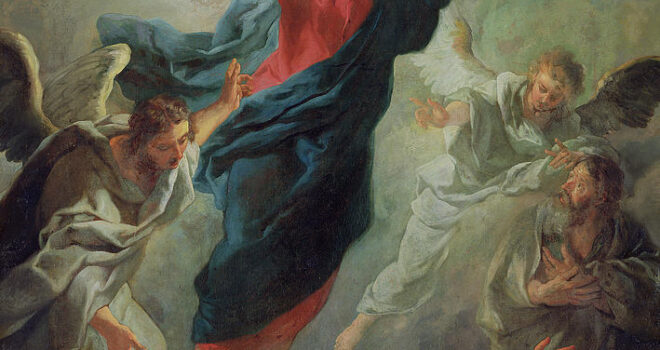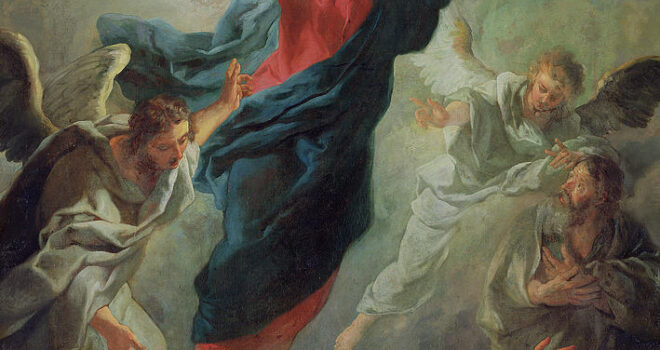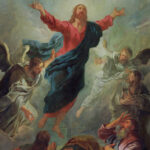Not far from the Pater Noster Church on the Mount of Olives in Jerusalem is the diminutive Chapel of the Ascension. The famous fourth-century diarist Egeria, who reached this spot during her pilgrimage to the Holy Land, describes the footprints of our Lord still visible on “Ascension Rock,” which, once housed within an impressive Byzantine church, is now surrounded by a small, stone edicule.
The stark simplicity of this venerable shrine is a fitting monument to the admonition of the two men dressed in white on the day of Jesus’s Ascension: “Men of Galilee, why are you standing there looking at the sky? This Jesus who has been taken up from you into heaven will return in the same way as you have seen him going into heaven” (Acts 1:11).
As we await His return, where do we turn our eyes? Where do we see Jesus? To what do we direct our attention?
To answer these questions, we must acknowledge two integrally related theological aspects of the mystery of the Ascension. The first is that Jesus ascended into heaven in order to empower the apostles for their mission in the world. Jesus returned to the Father so that the Father could send the Advocate, the Holy Spirit, in his name (cf. Jn 14:25) so as to strengthen the apostles for their ministry.
The second aspect is equally fundamentally and perhaps theologically prior. Namely, Christ took our human nature up to heaven so that we would now live with the Father mysteriously in Jesus, even while still dwelling on this earth. This is a basic element of Saint Paul’s experience of Christ and a central message of His preaching. Having been crucified with Christ, Paul no longer lives, but Christ lives in him (Col. 2:20), and the Apostle constantly reminds us that Christ lives in us as well (2 Cor. 13:5; Rom 8:10; 2 Cor. 4:6-7; Gal. 1:15-16; et al.). It is precisely our human nature dwelling – in Christ – with the Father’s divinity in heaven that makes possible a new, spirit-filled life after Jesus’s ascension and the sending of the Holy Spirit.
The disciples of Jesus are not exhorted to stop looking for Him in the sky simply so that they can get busy with the Master’s work on earth. They are certainly called to do that. But what empowers them to do that is precisely the conviction that they, too, are already mysteriously present with the Father in the humanity of Christ now reigning in heaven. They were able to perform miracles in His name not only because they have been granted His divine power, but because Jesus Himself was now present with God the Father in His human nature, thus presenting their human nature as a continual gift to the Father. “If then you were raised with Christ, seek what is above, where Christ is seated at the right hand of God. Think of what is above, not of what is on earth” (Col. 3:1-2). We, like the disciples who watched Jesus ascend into the heavens, will not be persuaded of our presence with the Father in heaven – and Jesus’s presence with us on earth – through the physical sense of sight, but rather through a spiritual sense by which we are convinced of our spiritual adoption as God’s children (cf. John 1:12).
In a homily delivered on the Ascension, Saint Leo the Great (c. 400 – 461 A.D.) ardently reminded his audience that “our poor human nature was carried up, in Christ, above all the hosts of heaven, above all the ranks of angels, beyond the highest heavenly powers to the very throne of God the Father” (Patrologia Latina, 54, 397). How breathtaking! Although we await the end times and the fulfilment of all things in Christ, our human nature is already there, gloriously reigning in the Person of Jesus Christ seated on the heavenly throne. Only when we contemplate this marvelous truth do we become fully aware that Jesus, after His ascension, is “indescribably more present in his divinity to those from whom he was further removed in his humanity” (ibid.).
How Jesus’s humanity – something we would expect to be only experienceable within the dimensions of space and time and matter – exists in a realm beyond those dimensions is no less mysterious than how His divinity – something that infinitely transcends the dimensions of space and times and matter – becomes substantially present in the earthly elements of bread and wine in the Most Holy Eucharist. I fear the Western Church has considerably less appreciation for the first of these mysteries than the Eastern Churches. In the Western Church, we tend to focus on the Body of Christ in the Eucharist (which it certainly is!) and on the Body of Christ as the Church, but we often overlook that both are based on the Body of Christ dwelling eternally in heaven at the Father’s right hand. Yet whenever we profess in the Creed that that indeed is where Christ dwells, we are professing that he lives there bodily, as Saint John Damascene teaches: “By ‘the Father’s right hand’ we understand the glory and honor of divinity, where he who exists as Son of God before all ages, indeed as God, of one being with the Father, is seated bodily (sōmati) after he became incarnate and his flesh was glorified” (Patrologia Graeca, 94, 1104C; cf. CCC 663). All the more reason to avail ourselves of the spiritual food of Holy Communion and to seek opportunities to contemplate both mysteries – i.e., that of our human nature in heaven and that of the divine nature on earth – through Eucharistic Adoration.
But we must beware. Acknowledging that our human nature dwells in heaven with the Father in Jesus neither lessens our free-will nor eliminates our tendency to sin. Mastering the former and extirpating the latter from our lives are the keys to holiness, and the job is never done. Dietrich von Hildebrand wisely wrote that “even after the Redemption … earthly existence has remained a status viae. In many respects, the painful duality inherent in our earthly situation endures unchanged” (Transformation in Christ, 449).
Hence the need to celebrate the Solemnity of the Assumption every year. Hence the need to keep our eyes fixed on the Eucharistic Lord: i.e., the Christ whose human nature – and in whom our human nature – now dwells with the Father in heaven.












